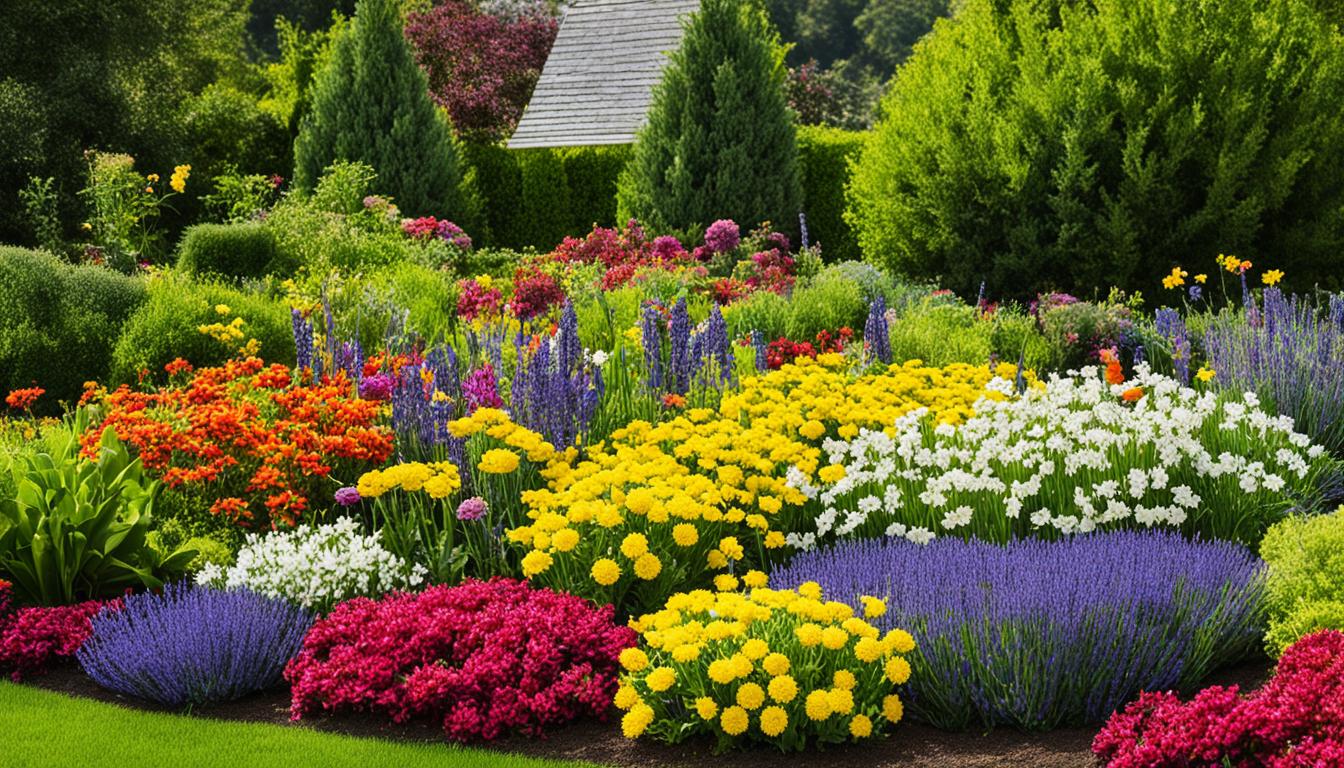Are you looking to create a vibrant and nature-friendly garden? One that attracts the delightful presence of bees and butterflies, while also improving pollinator populations? In this article, I will share with you some valuable gardening tips and ideas to help you create a pollinator-friendly habitat right in your own backyard.
Key Takeaways:
- Creating a pollinator-friendly garden is essential to support bees, butterflies, and other pollinators.
- Bees and butterflies play a crucial role in pollinating crops and wild plants, but their populations are declining.
- Design your garden to provide food, shelter, and water for pollinators.
- Choose the right plants, including native varieties, that are rich in nectar and pollen.
- Avoid using pesticides and embrace organic gardening practices to protect pollinators.
Why Pollinators Need Your Garden
Pollinators, such as bees, butterflies, and other insects, are essential for the pollination of crops and wild plants. Their role in agriculture is vital, as they facilitate the transfer of pollen from the male part of a flower to the female part, enabling plant reproduction. However, these important creatures are currently facing a significant decline in populations, which poses a threat to both our food production and the ecosystem as a whole.
The importance of pollinators cannot be overstated. They contribute to the production of approximately 75% of globally grown crops, including fruits, vegetables, nuts, and seeds. According to the Food and Agriculture Organization (FAO), pollinators are directly responsible for increasing the yields of 87 of the leading food crops worldwide. In addition to their impact on agriculture, pollinators also play a crucial role in maintaining the balance of natural ecosystems by promoting biodiversity.
Unfortunately, the populations of many pollinators, including bees and butterflies, are declining at an alarming rate. Various factors, such as habitat loss, pesticide exposure, climate change, and diseases, contribute to this decline. If the downward trend continues, it could have severe consequences for our food security and the stability of ecosystems.
“The decline of pollinator populations poses a significant threat to global food production and ecosystem health alike.”
One of the most critical factors contributing to the decline of pollinator populations is the destruction and fragmentation of their habitats. As natural areas and diverse plant populations shrink, pollinators lose the resources they need for survival, including nectar, pollen, and nesting sites. By providing suitable habitats in our gardens, we create safe havens for pollinators and help mitigate the effects of habitat loss.
Gardens that are designed with pollinators in mind not only provide crucial resources but also act as stepping stones and corridors, enabling pollinators to move between fragmented habitats. These “pollinator-friendly” gardens can play a significant role in conserving and restoring pollinator populations, contributing to the overall health and resilience of ecosystems.
| Pollinators in Agriculture | Reasons for Decline of Pollinator Populations | Implications of Decline |
|---|---|---|
| Enhance crop productivity Facilitate fruit and seed production Promote genetic diversity in plants |
Habitat loss and fragmentation Pesticide exposure Climate change Diseases and parasites |
Reduced crop yields and quality Loss of biodiversity Disruption of ecosystem services Threats to global food security |
Gardening for pollinators is not only a responsibility but also an opportunity to make a positive impact on the environment. By providing suitable habitats, planting pollinator-friendly flowers, and avoiding the use of harmful pesticides, we can contribute to the conservation of these essential creatures and help reverse their declining populations.
In the following sections, we will explore practical tips and ideas for creating a pollinator-friendly garden, choosing the right plants, and adopting organic gardening practices that benefit both pollinators and our own well-being. Let’s embark on this journey together and make a difference for pollinators in our own backyards!
Creating a Pollinator-Friendly Habitat
Creating a pollinator-friendly habitat is not only beneficial for bees, butterflies, and other pollinators but also for the health and vibrancy of your garden. By designing your garden to provide food, shelter, and water, you can create an inviting space that attracts and supports these important creatures.
Here are some tips to help you create a welcoming environment for pollinators:
- Incorporate native plants: Native plants are well-suited to the local climate and provide abundant nectar and pollen for pollinators. They also support local ecosystems. Research and choose native plant species that are attractive to bees and butterflies.
- Leave wild spaces: Avoid over-manicuring your garden. Leave some areas untamed and wild to provide shelter and nesting sites for pollinators. Fallen logs, leaf piles, or a corner of tall grass can create valuable habitats.
- Provide water sources: Pollinators need access to clean water for drinking and bathing. Install a shallow birdbath or create a small water feature with rocks or pebbles where they can perch safely.
- Offer shelter: Create sheltered areas in your garden where pollinators can take refuge from extreme weather conditions, such as strong winds or intense heat. Install bee houses, brush piles, or a variety of plants with dense foliage.
By implementing these garden design strategies, you can transform your outdoor space into a thriving pollinator habitat. Not only will you enjoy the beauty and activity of bees and butterflies, but you will also contribute to the conservation of these essential creatures.
Creating a pollinator-friendly garden provides a vibrant habitat for bees, butterflies, and other important pollinators.
Choosing the Right Plants
The right choice of plants is essential for attracting and supporting pollinators in your garden. By selecting plants that provide abundant nectar and pollen, you can create a thriving habitat for bees and butterflies. Native plants are particularly beneficial for pollinators, as they have evolved to support their needs and are well-suited to the local ecosystem.
When choosing plants for pollinators, look for varieties that are known to attract bees and butterflies. These nectar-rich flowers serve as a valuable food source and help sustain pollinator populations. Here are some examples of pollinator-friendly plants:
| Native Plants | Nectar-rich Flowers | Pollinator-Friendly Shrubs |
|---|---|---|
| Butterfly Weed | Echinacea | Blueberries |
| Bee Balm | Liatris | Spirea |
| Goldenrod | Salvia | Lilac |
| Milkweed | Phlox | Viburnum |
Planting a variety of flowers that bloom from early spring to late fall ensures a continuous supply of nectar and pollen for pollinators throughout the year. This diverse range of blooms also adds vibrant colors and visual appeal to your garden.
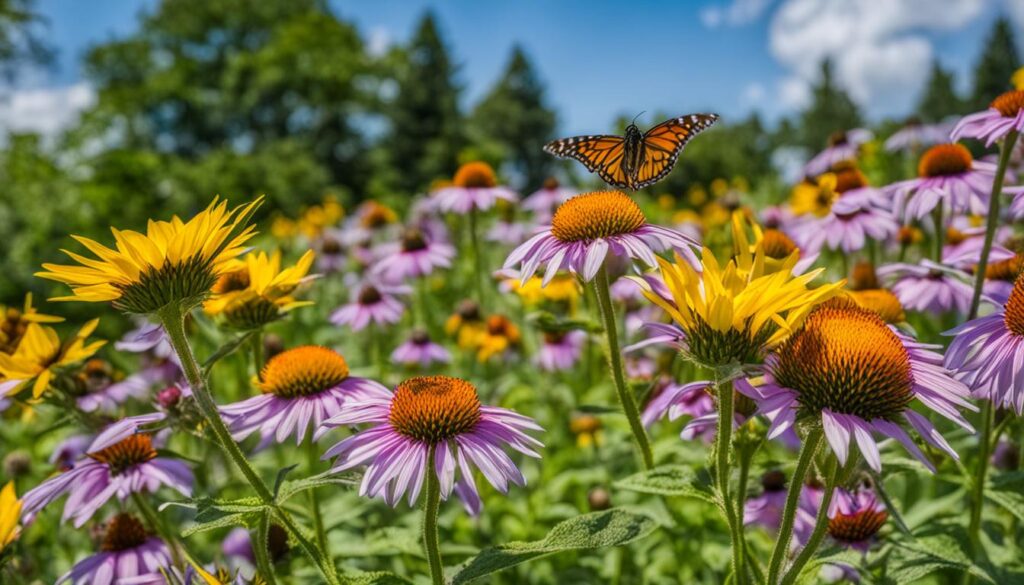
Remember to provide a mix of annuals and perennials, as well as plants with different shapes and sizes to accommodate a wide range of pollinators. Including a variety of flower types, such as tubular-shaped flowers for hummingbirds or flat-topped flowers for butterflies, caters to the specific preferences of different pollinator species.
Incorporating pollinator-friendly shrubs into your garden not only adds height and structure but also provides additional food and shelter for bees and butterflies. These shrubs serve as important foraging and nesting sites, contributing to the overall health and vitality of your pollinator habitat.
By carefully selecting the right plants, you can create a haven for pollinators in your own backyard, supporting their crucial work while enjoying the beauty and benefits of a thriving garden.
Organic Gardening for Pollinators
When it comes to creating a thriving habitat for pollinators, organic gardening practices are the way to go. Not only do these practices prioritize the health and well-being of bees, butterflies, and other insects, but they also support the overall ecological balance of your garden.
One of the main concerns for pollinators is the use of pesticides, particularly neonicotinoid pesticides. These chemicals have been linked to harmful effects on pollinators, including disruptions to their navigation, reproduction, and immune systems. By choosing organic gardening methods, we can reduce the exposure of these essential creatures to toxic substances and create a safe environment for them to thrive.
“Organic gardening methods reduce the exposure of pollinators to harmful pesticides, allowing them to fulfill their crucial role in the ecosystem.”
So, how can you practice pesticide-free gardening? Here are some steps you can take:
- Avoid using synthetic pesticides: Instead, opt for natural alternatives like insecticidal soaps, neem oil, or beneficial insect releases to control pests in your garden.
- Focus on prevention: Maintain healthy soil, practice crop rotation, and encourage natural predators to keep pest populations in check.
- Embrace companion planting: Grow plants that naturally repel pests or attract beneficial insects to create a balanced ecosystem in your garden.
- Integrate biodiversity: Plant a diverse range of flowers, herbs, and vegetables to provide food and habitat for a variety of pollinators.
Benefits of Organic Gardening for Pollinators
By adopting organic gardening methods, you not only protect pollinators but also reap several benefits for your garden:
- Healthier plants: Organic gardening techniques strengthen plants’ natural defenses, making them more resistant to pests and diseases.
- Improved soil quality: Organic practices enhance soil fertility and structure, promoting the growth of beneficial microorganisms that support plant health.
- Reduced chemical exposure: By eliminating synthetic pesticides, you minimize your family’s exposure to potentially harmful chemicals.
Incorporating organic gardening practices into your routine is a small but significant step towards preserving pollinators and creating a sustainable ecosystem in your garden.
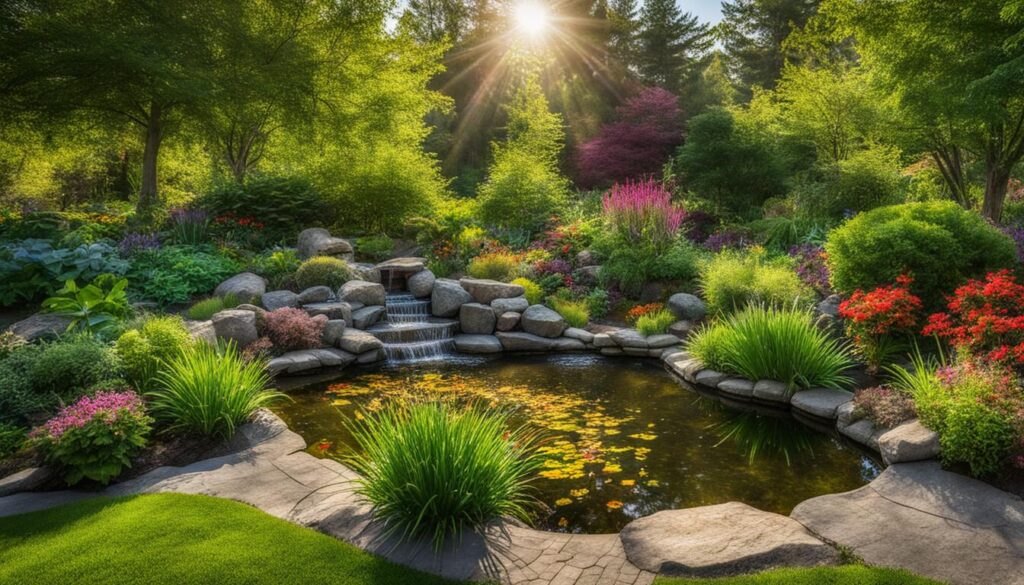
Where to Shop for Pollinator-Safe Plants
When it comes to creating a pollinator-friendly garden, not all plants you find in garden stores are safe for our buzzing friends. It’s important to choose plants that are free from harmful chemicals, such as neonicotinoids, and instead opt for pollinator-safe plants that support the well-being of bees, butterflies, and other beneficial insects.
So, where can you find these pollinator-safe plants? To help you on your gardening journey, I recommend checking out organic nurseries and smaller garden centers that specialize in organic gardening practices. These establishments prioritize the use of neonicotinoid-free plants, ensuring that your garden is a safe haven for pollinators.
Benefits of Buying from Organic Nurseries
Organic nurseries offer several advantages when it comes to finding pollinator-safe plants. Here are a few benefits:
- Chemical-Free: Organic nurseries prioritize organic growing methods, which means their plants are grown without the use of synthetic pesticides or fertilizers. This ensures that the plants you purchase are free from harmful chemicals that can harm pollinators.
- Supporting Sustainable Practices: By purchasing from organic nurseries, you are supporting environmentally-friendly practices that help improve soil health and promote biodiversity. These nurseries often focus on providing native and organic plants that are well-suited to your local ecosystem.
- Expertise and Advice: The staff at organic nurseries are often knowledgeable about pollinator-friendly gardening practices. They can provide you with valuable guidance on plant selection, care, and creating a welcoming environment for pollinators.
By seeking out organic nurseries, you not only ensure that the plants you bring home are pollinator-safe, but you also contribute to the larger movement of promoting sustainable and eco-friendly gardening practices.
Supporting Pollinator-Safe Stores
When visiting garden stores, it’s essential to ask the staff if the plants they carry are neonicotinoid-free and safe for pollinators. By actively seeking pollinator-safe plants and supporting stores that prioritize the well-being of bees and butterflies, you can make a positive impact on pollinator conservation.
Additionally, consider spreading the word about the importance of pollinator-safe plants to your fellow gardeners, friends, and neighbors. Encourage them to choose plants that are free from harmful chemicals and to support stores that prioritize the health of our pollinator friends.
Organic Nurseries and Pollinator-Safe Stores
| Nursery/Store Name | Location | Specializations |
|---|---|---|
| Sunny Meadows Organic Nursery | Portland, OR | Organic plants, native species |
| Nectar Garden Center | Austin, TX | Pollinator-friendly plants, organic gardening supplies |
| Growing Green Nursery | Seattle, WA | Native plants, pesticide-free options |
| The Bee’s Knees Garden Shop | Brooklyn, NY | Organic gardening, pollinator-friendly plants |
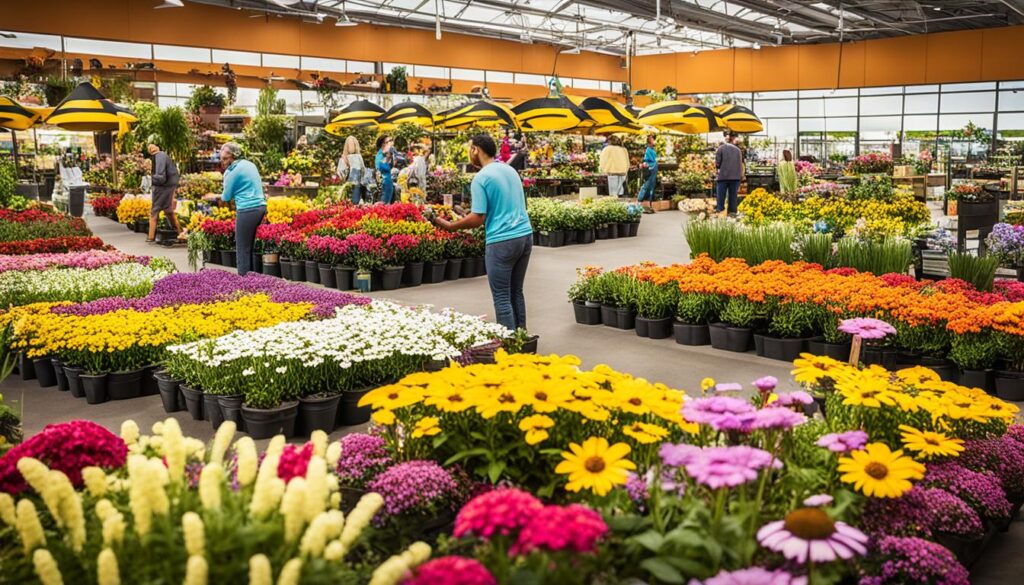
The Importance of Milkweed for Monarch Butterflies
Milkweed plays a critical role in the survival of monarch butterflies, whose populations have experienced a significant decline in recent years. By planting milkweed in your garden, you provide essential food and habitat for monarch caterpillars and adult butterflies, helping to support their dwindling populations.
The decline of monarch populations is a cause for concern and requires immediate action. Factors such as habitat loss, pesticide use, and changes in agricultural practices have contributed to the decline of milkweed, the primary host plant for monarchs. Without sufficient milkweed, monarch butterflies face challenges in finding suitable areas for breeding and food sources for their caterpillars.
Incorporating milkweed into your garden helps create a welcoming environment for monarch butterflies and encourages their continued reproduction and survival. Additionally, milkweed attracts other pollinators, such as bees and butterflies, contributing to the overall health and diversity of your garden ecosystem.
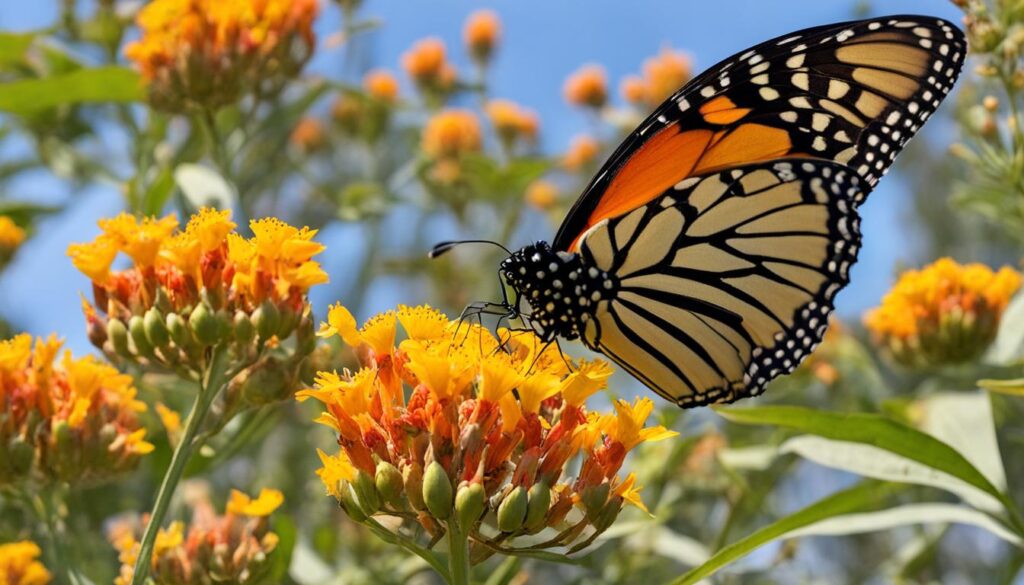
“The survival of monarch butterflies depends on the availability of milkweed, their essential host plant. By planting milkweed in your garden, you play a vital role in supporting monarch populations and protecting these beautiful creatures.”
When selecting milkweed for your garden, choose native species that are well-adapted to your local climate and soil conditions. Common milkweed (Asclepias syriaca) and butterfly milkweed (Asclepias tuberosa) are two popular species that provide excellent habitat for monarchs.
In addition to serving as a host plant, milkweed offers nectar-rich flowers that provide food for adult monarchs and other pollinators. The brightly colored blooms of milkweed plants not only add beauty to your garden but also attract a variety of beneficial insects.
By including milkweed in your garden, you contribute to the conservation efforts aimed at reversing the decline of monarch populations. Planting milkweed not only benefits monarch butterflies but also raises awareness about the importance of creating pollinator-friendly habitats and protecting our valuable pollinators.
Providing Water for Pollinators
As I mentioned earlier, pollinators like bees and butterflies need access to water for drinking and bathing. By providing water sources in your garden, you can create a welcoming environment that supports their needs. Water sources not only help in hydrating pollinators but also provide them with a safe space to cool off and clean themselves.
One of the simplest ways to offer water to pollinators is by creating shallow pools or birdbaths in your garden. These can be made using shallow containers or trays filled with water. To make them more inviting, add rocks or pebbles for pollinators to perch on while they drink or groom their wings.
It is crucial to keep the water fresh and clean to ensure the health and well-being of the pollinators. Stagnant water can become a breeding ground for mosquitoes, which can be harmful to both humans and pollinators. Remember to empty and refill the water sources regularly to prevent mosquito larvae from developing.
Creating butterfly puddles is another effective way to provide water for butterflies. These are small depressions in the ground filled with moist sand or soil. Adding water to the depression creates a muddy spot that butterflies can visit for essential minerals and nutrients. To enhance the effectiveness of butterfly puddles, consider placing them near nectar-rich flowers or in sunny areas of your garden.
“Water is an essential resource for pollinators. By providing them with clean and accessible water sources, we can play a significant role in supporting their well-being and overall population.” – Garden Expert
Remember, a well-hydrated pollinator is a healthy pollinator. By incorporating water sources into your garden, you are not only fulfilling their basic needs but also contributing to the overall conservation and protection of these vital creatures.
Becoming a Community Scientist
Getting involved in community science projects can be a meaningful way to contribute to pollinator conservation. As a citizen scientist, you can actively participate in research and monitoring programs focused on pollinators, such as bees and butterflies. Community science, also known as citizen science, refers to the collaboration between scientists and the general public to collect data and conduct scientific research. It offers a unique opportunity for individuals to contribute to scientific knowledge and make a positive impact on the environment.
By engaging in participatory environmental research, you can help scientists gather valuable data that contributes to our understanding of pollinator populations, behaviors, and habitats. This information is crucial for implementing effective conservation strategies and ensuring the survival of these vital species.
Participating in community science initiatives allows you to actively contribute to the scientific community while deepening your knowledge and appreciation for pollinators. You’ll have the chance to learn from experts, collaborate with fellow enthusiasts, and become part of a wider network of individuals passionate about environmental conservation.
Benefits of Community Science
Engaging in community science brings numerous benefits, both on a personal level and for the larger scientific community:
- Educational Opportunities: Community science projects provide a unique learning experience, allowing you to gain knowledge about pollinators, ecology, and environmental conservation.
- Contribution to Conservation: Your participation directly contributes to pollinator conservation efforts, helping to protect these important species and preserve their habitats.
- Building Awareness: By becoming a citizen scientist, you can raise awareness about the importance of pollinators and inspire others to get involved in conservation efforts.
- Real-World Impact: Your data and observations contribute to scientific research, helping scientists make informed decisions and shape policies for pollinator conservation.
- Engaging with a Community: Joining community science initiatives connects you with like-minded individuals who share your passion for environmental stewardship, fostering a sense of belonging and collective action.
So, how can you get involved in community science? Numerous organizations and projects offer opportunities for individuals to contribute to pollinator research. Whether it’s monitoring pollinator populations, collecting data on plant-pollinator interactions, or mapping pollinator habitats, there are various ways to participate based on your interests and available time.
Example of a Community Science Program: The Great Pollinator Project
One well-known community science project focused on pollinators is The Great Pollinator Project. This initiative aims to create a comprehensive database of pollinators and their habitats across North America. Participants are encouraged to observe and document pollinators, particularly bees, within their communities.
By submitting their observations to the project’s website, citizen scientists contribute to a growing database that helps researchers understand pollinator populations and their geographic distribution. The data collected through The Great Pollinator Project enables scientists to identify trends, monitor changes, and develop targeted conservation strategies.
Engaging in community science projects like The Great Pollinator Project empowers individuals to play an active role in shaping the future of pollinator conservation. By becoming a citizen scientist, you can explore the fascinating world of pollinators, make a difference in protecting these vital species, and contribute to scientific research.
| Benefits of Community Science | How to Get Involved | Example Community Science Program |
|---|---|---|
|
|
|
Conclusion
In conclusion, gardening for pollinators is not just a hobby or a pastime; it is a vital conservation effort that has far-reaching impacts. Throughout this article, we have explored the importance of pollinators, their alarming decline, and the role each of us can play in their conservation.
By creating a pollinator-friendly habitat in our own gardens, we can provide crucial food, shelter, and water sources for bees, butterflies, and other pollinators. It is through these collective efforts that we can make a significant difference in improving pollinator populations.
I encourage you to take action today. Plant native flowers that are rich in nectar and pollen, avoid using harmful pesticides, and provide water sources for pollinators. By doing so, you are not only creating a beautiful and nature-friendly garden but also contributing to the conservation of these essential creatures.
Remember, every small step counts. Whether you have a small balcony or a sprawling backyard, there are opportunities for everyone to make a positive impact. Together, we can ensure a thriving future for bees, butterflies, and other pollinators and the vital ecosystem services they provide.
FAQ
Why are pollinators important?
Pollinators play a crucial role in the pollination of crops and wild plants. They transfer pollen from the male to the female parts of flowers, allowing plants to produce seeds and fruits.
What are the consequences of declining pollinator populations?
The decline of pollinators could have severe consequences for agriculture. Many fruits, vegetables, and nuts depend on pollinators for reproduction, and without them, food production could be greatly reduced.
How can I create a pollinator-friendly habitat in my garden?
You can create a pollinator-friendly garden by incorporating native plants, leaving wild spaces, providing water sources, and offering shelter for bees, butterflies, and other pollinators.
Which plants are good for attracting pollinators?
Plants that are rich in nectar and pollen are attractive to pollinators. Native plants and specific varieties of flowers that bloom from early spring to late fall are excellent choices for attracting bees and butterflies.
Why is organic gardening important for pollinators?
Organic gardening practices are crucial for the health and well-being of pollinators. Pesticides, especially neonicotinoids, can harm bees, butterflies, and other beneficial insects. Avoiding pesticide use and promoting organic methods can help protect pollinators.
Where can I find pollinator-safe plants?
You can find pollinator-safe plants at organic nurseries and smaller garden centers that specialize in organic gardening. Always ask for pollinator-safe plants and support stores that prioritize the well-being of bees and butterflies.
Why is milkweed important for monarch butterflies?
Milkweed is crucial for the survival of monarch butterflies. Monarch caterpillars can only eat milkweed, and adult monarchs rely on milkweed flowers for nectar. Planting milkweed in your garden provides food and habitat for these beautiful butterflies.
How can I provide water for pollinators?
You can provide water for pollinators by creating shallow pools or birdbaths with rocks or pebbles for them to perch on. Keeping the water fresh and avoiding standing water is important to prevent mosquito breeding.
How can I become a community scientist and contribute to pollinator conservation?
You can become a community scientist by participating in research and monitoring programs focused on pollinators. These programs allow individuals to collect data and contribute to scientific studies, helping to improve our understanding of pollinator populations.
Why is gardening for pollinators important?
Gardening for pollinators is crucial for improving and protecting pollinator populations. By creating welcoming habitats in our own gardens and communities, we can help ensure the survival of bees, butterflies, and other pollinators, which are essential for food production and the health of our ecosystems.

